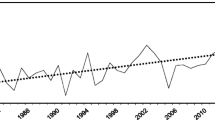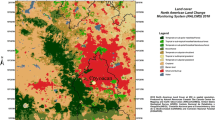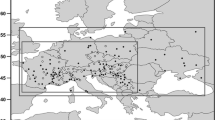Abstract
Climate change affects the reproductive life cycles of plants, including pollen production, which has consequences for allergic respiratory diseases. We examined climatic trends at eight locations in Bavaria, Southern Germany, with pollen time series of at least 10 years (up to 30 years in Munich). Climate change in Bavaria was characterized by a rise in temperature, but not during the winter. There is also a trend towards a more continental climate in Bavaria, which is significant in the Alps in the south of the territory. The influence of climate change depended on pollen type. Wind-pollinated arboreal species (e.g. Alnus, Betula and Cupressaceae/Taxaceae) showed advances in the start and end dates of pollen seasons and an increase in pollen load. These changes correlated negatively with late-winter (February) and spring temperatures (April). For herbaceous species, like Poaceae and Urticaceae, an earlier season was observed. Although precipitation is not a limiting factor in Southern Germany, water availability in the spring did influence the magnitude of grass pollen seasons. The effect of climatic change on the characteristics of pollen seasons was also more pronounced at higher altitudes, significant at > 800 m above sea level. Our results show that trends for start, end dates and intensity were similar at all locations, but only statistically significant at some. If we assume that earlier and more intense pollen seasons result in increases in prevalence and severity of allergic diseases, then the effect of climate change on public health in Bavaria may be significant.







Similar content being viewed by others
References
Anders I, Stagl J, Auer I, Pavlik D (2014) Climate change in central and eastern Europe. In: Rannow S, Neubert M (eds) Managing protected areas in central and eastern Europe under climate change. Springer, Dordrecht, pp 17–30
Andersen TB (1991) A model to predict the beginning of the pollen season. Grana 30:269–275. https://doi.org/10.1080/00173139109427810
Ariano R, Canonica GW, Passalacqua G (2010) Possible role of climate changes in variations in pollen seasons and allergic sensitizations during 27 years. Ann Allergy Asthma Immunol 104:215–222. https://doi.org/10.1016/j.anai.2009.12.005
Barnes CS (2018) Impact of climate change on pollen and respiratory disease. Curr Allergy Asthma Rep 18. https://doi.org/10.1007/s11882-018-0813-7
Beck HE, Zimmermann NE, McVicar TR, Vergopolan N, Berg A et al (2018) Present and future Köppen-Geiger climate classification maps at 1-km resolution. Sci Data 5:180214. https://doi.org/10.1038/sdata.2018.214
Biedermann T, Winther L, Till SJ, Panzner P, Knulst A et al (2019) Birch pollen allergy in Europe. Allergy all.13758. https://doi.org/10.1111/all.13758
Buters J, Alberternst B, Nawrath S, Wimmer M, Traidl-Hoffmann C et al (2015a) Ambrosia artemisiifolia (ragweed) in Germany–current presence, allergological relevance and containment procedures. Allergo J Int 24:108–120. https://doi.org/10.1007/s40629-015-0060-6
Buters J, Prank M, Sofiev M, Pusch G, Albertini R et al (2015b) Variation of the group 5 grass pollen allergen content of airborne pollen in relation to geographic location and time in season. J Allergy Clin Immunol 136:87–95.e6. https://doi.org/10.1016/j.jaci.2015.01.049
Buters JTM, Antunes C, Galveias A, Bergmann KC, Thibaudon M et al (2018) Pollen and spore monitoring in the world. Clin Transl Allergy 8. https://doi.org/10.1186/s13601-018-0197-8
Buters JTM, Thibaudon M, Smith M, Kennedy R, Rantio-Lehtimäki A (2012) Release of Bet v 1 from birch pollen from 5 European countries. Results from the HIALINE study. Atmos Environ 55:496–505. https://doi.org/10.1016/j.atmosenv.2012.01.054
Bykova O, Chuine I, Morin X (2019) Highlighting the importance of water availability in reproductive processes to understand climate change impacts on plant biodiversity. Perspect Plant Ecol Evol Syst 37:20–25. https://doi.org/10.1016/j.ppees.2019.01.003
Caccianiga M, Andreis C, Armiraglio S, Leonelli G, Pelfini M et al (2008) Climate continentality and treeline species distribution in the Alps. Plant Biosyst - Int J Deal Asp Plant Biol 142:66–78. https://doi.org/10.1080/11263500701872416
Campoy JA, Ruiz D, Egea J (2011) Dormancy in temperate fruit trees in a global warming context: a review. Sci Hortic 130:357–372. https://doi.org/10.1016/j.scienta.2011.07.011
Cleland E, Chuine I, Menzel A, Mooney H, Schwartz M (2007) Shifting plant phenology in response to global change. Trends Ecol Evol 22:357–365. https://doi.org/10.1016/j.tree.2007.04.003
Cohen JL, Furtado JC, Barlow M, Alexeev VA, Cherry JE et al (2012) Asymmetric seasonal temperature trends. Geophys Res Lett 39(4). https://doi.org/10.1029/2011GL050582
Core Team R (2019) R: a language and environment for statistical computing. R Foundation for Statistical Computing, Vienna, AustriaRetrieved from https://www.R-project.org/
Cornes RC, van der Schrier G, van den Besselaar EJM, Jones PD (2018) An ensemble version of the E-OBS temperature and precipitation data sets. J Geophys Res Atmospheres 123:9391–9409. https://doi.org/10.1029/2017JD028200
Damialis A, Traidl-Hoffmann C, Treudler R (2019) Climate change and pollen allergies. In: Marselle MR, Stadler J, Korn H et al (eds) Biodiversity and health in the face of climate change. Springer International Publishing, Cham, pp 47–66
Doblas-Miranda E, Alonso R, Arnan X, Bermejo V, Brotons L et al (2017) A review of the combination among global change factors in forests, shrublands and pastures of the Mediterranean Region: beyond drought effects. Glob Planet Change 148:42–54. https://doi.org/10.1016/j.gloplacha.2016.11.012
Doi H, Gordo O, Mori T, Kubo MT (2017) A macroecological perspective for phenological research under climate change. Ecol Res 32:633–641. https://doi.org/10.1007/s11284-017-1480-1
Durham SR, Nelson HS, Nolte H, Bernstein DI, Creticos PS et al (2014) Magnitude of efficacy measurements in grass allergy immunotherapy trials is highly dependent on pollen exposure. Allergy 69:617–623. https://doi.org/10.1111/all.12373
Falk W, Mellert KH (2011) Species distribution models as a tool for forest management planning under climate change: risk evaluation of Abies alba in Bavaria. J Veg Sci 22:621–634. https://doi.org/10.1111/j.1654-1103.2011.01294.x
Fawcett AA, Iyer GC, Clarke LE, Edmonds JA, Hultman NE et al (2015) Can Paris pledges avert severe climate change? Science 350:1168–1169. https://doi.org/10.1126/science.aad5761
Galán C, Alcázar P, Oteros J, García-Mozo H, Aira MJ et al (2016) Airborne pollen trends in the Iberian Peninsula. Sci Total Environ 550:53–59. https://doi.org/10.1016/j.scitotenv.2016.01.069
Galán C, Ariatti A, Bonini M, Clot B, Crouzy B et al (2017) Recommended terminology for aerobiological studies. Aerobiología 33:293–295. https://doi.org/10.1007/s10453-017-9496-0
Galán C, Smith M, Thibaudon M, Frenguelli G, Oteros J et al (2014) Pollen monitoring: minimum requirements and reproducibility of analysis. Aerobiologia 30:385–395. https://doi.org/10.1007/s10453-014-9335-5
Garcia RA, Cabeza M, Rahbek C, Araujo MB (2014) Multiple dimensions of climate change and their implications for biodiversity. Science 344:1247579–1247579. https://doi.org/10.1126/science.1247579
García-Mozo H (2017) Poaceae pollen as the leading aeroallergen worldwide: a review. Allergy 72:1849–1858. https://doi.org/10.1111/all.13210
Ghitarrini S, Tedeschini E, Timorato V, Frenguelli G (2017) Climate change: consequences on the pollination of grasses in Perugia (Central Italy). A 33-year-long study. Int J Biometeorol 61:149–158. https://doi.org/10.1007/s00484-016-1198-8
Gordo O, Sanz JJ (2010) Impact of climate change on plant phenology in Mediterranean ecosystems. Glob Change Biol 16:1082–1106. https://doi.org/10.1111/j.1365-2486.2009.02084.x
Guiot J, Cramer W (2016) Climate change: the 2015 Paris Agreement thresholds and Mediterranean basin ecosystems. Science 354:465–468. https://doi.org/10.1126/science.aah5015
Haftenberger M, Laußmann D, Ellert U, Kalcklösch M, Langen U et al (2013) Prevalence of sensitisation to aeroallergens and food allergens: results of the German Health Interview and Examination Survey for Adults (DEGS1). Bundesgesundheitsbl Gesundheitsforsch Gesundheitsschutz 56:687–697. https://doi.org/10.1007/s00103-012-1658-1
Hamaoui-Laguel L, Vautard R, Liu L, Solmon F, Viovy N et al (2015) Effects of climate change and seed dispersal on airborne ragweed pollen loads in Europe. Nat Clim Chang 5:766–771. https://doi.org/10.1038/nclimate2652
Hirst JM (1952) An automatic volumetric spore trap. Ann Appl Biol 39:257–265. https://doi.org/10.1111/j.1744-7348.1952.tb00904.x
IPCC (2014) Climate change 2014: synthesis report. Contribution of Working Groups I, II and III to the Fifth Assessment Report of the Intergovernmental Panel on Climate Change [Core Writing Team, R.K. Pachauri and L.A. Meyer (eds.)]. IPCC, Geneva, Switzerland
Katelaris CH, Beggs PJ (2018) Climate change: allergens and allergic diseases. Intern Med J 48:129–134. https://doi.org/10.1111/imj.13699
Kim KR, Oh J-W, Woo S-Y, Seo YA, Choi Y-J et al (2018) Does the increase in ambient CO2 concentration elevate allergy risks posed by oak pollen? Int J Biometeorol 62:1587–1594. https://doi.org/10.1007/s00484-018-1558-7
Knutti R, Rogelj J, Sedláček J, Fischer EM (2016) A scientific critique of the two-degree climate change target. Nat Geosci 9:13–18. https://doi.org/10.1038/ngeo2595
Köppen W (1936) Das geographische System der Klimate. In: Handbuch der Klimatologie, Bd.1. Teil C. Borntraeger, Berlin, p 44
Kosanic A, Kavcic I, van Kleunen M, Harrison S (2019) Climate change and climate change velocity analysis across Germany. Sci Rep 9:2196. https://doi.org/10.1038/s41598-019-38720-6
Kottek M, Grieser J, Beck C, Rudolf B, Rubel F et al (2006) World Map of the Köppen-Geiger climate classification updated. Meteorol Z 15:259–263. https://doi.org/10.1127/0941-2948/2006/0130
Lake IR, Jones NR, Agnew M, Goodess CM, Giorgi F et al (2017) Climate change and future pollen allergy in Europe. Environ Health Perspect 125:385–391. https://doi.org/10.1289/EHP173
Lind T, Ekebom A, Alm Kübler K, Östensson P, Bellander T et al (2016) Pollen season trends (1973-2013) in Stockholm area, Sweden. PLoS One 11:e0166887. https://doi.org/10.1371/journal.pone.0166887
Luedeling E, Girvetz EH, Semenov MA, Brown PH (2011) Climate change affects winter chill for temperate fruit and nut trees. PLoS One 6:e20155. https://doi.org/10.1371/journal.pone.0020155
Luterbacher J (2004) European seasonal and annual temperature variability, trends, and extremes since 1500. Science 303:1499–1503. https://doi.org/10.1126/science.1093877
Makra L, Matyasovszky I, Deák ÁJ (2011) Trends in the characteristics of allergenic pollen circulation in central Europe based on the example of Szeged, Hungary. Atmos Environ 45:6010–6018. https://doi.org/10.1016/j.atmosenv.2011.07.051
Matiu M, Ankerst DP, Menzel A (2016) Asymmetric trends in seasonal temperature variability in instrumental records from ten stations in Switzerland, Germany and the UK from 1864 to 2012. Int J Climatol 36:13–27. https://doi.org/10.1002/joc.4326
Menzel A, Sparks TH, Estrella N, Eckhardt S (2005) ‘SSW to NNE’–North Atlantic Oscillation affects the progress of seasons across Europe. Glob Change Biol 11:909–918. https://doi.org/10.1111/j.1365-2486.2005.00954.x
Miranda JD, Armas C, Padilla FM, Pugnaire FI (2011) Climatic change and rainfall patterns: effects on semi-arid plant communities of the Iberian Southeast. J Arid Environ 75:1302–1309. https://doi.org/10.1016/j.jaridenv.2011.04.022
Morellato LPC, Alberton B, Alvarado ST, Borges B, Buisson E et al (2016) Linking plant phenology to conservation biology. Biol Conserv 195:60–72. https://doi.org/10.1016/j.biocon.2015.12.033
Oteros J, García-Mozo H, Vázquez L, Mestre A, Domínguez-Vilches E et al (2019a) Spatial interpolation of current airborne pollen concentrations where no monitoring exists. Atmos Environ 199:435–442. https://doi.org/10.1016/j.atmosenv.2018.11.045
Oteros J, García-Mozo H, Vázquez L et al (2013) Modelling olive phenological response to weather and topography. Agric Ecosyst Environ 179:62–68. https://doi.org/10.1016/j.agee.2013.07.008
Oteros J, Sofiev M, Smith M, Clot B, Damialis A et al (2019b) Building an automatic pollen monitoring network (ePIN): selection of optimal sites by clustering pollen stations. Sci Total Environ 688:1263–1274. https://doi.org/10.1016/j.scitotenv.2019.06.131
Pérez-Badia R, Rapp A, Morales C, Sardinero S, Galán C et al (2010) Pollen spectrum and risk of pollen allergy in central Spain. Ann Agric Environ Med 17:139–151 www.aaem.pl/Pollen-spectrum-and-risk-of-pollen-allergy-in-central-Spain-,71626,0,2.html
Pfaar O, Bastl K, Berger U, Buters J, Calderon MA et al (2017) Defining pollen exposure times for clinical trials of allergen immunotherapy for pollen-induced rhinoconjunctivitis-an EAACI position paper. Allergy 72:713–722. https://doi.org/10.1111/all.13092
Piao S, Liu Q, Chen A, Janssens IA, Fu Y et al (2019) Plant phenology and global climate change: current progresses and challenges. Glob Change Biol 25:1922–1940. https://doi.org/10.1111/gcb.14619
Rodríguez A, Pérez-López D, Sánchez E, Centeno A, Gómara I et al (2019) Chilling accumulation in fruit trees in Spain under climate change. Nat Hazards Earth Syst Sci 19:1087–1103. https://doi.org/10.5194/nhess-19-1087-2019
Rojo J, Oteros J, Picornell A, Ruëff F, Werchan B et al (2020) Land-use and height of pollen sampling affect pollen exposure in Munich, Germany. Atmosphere 11:145. https://doi.org/10.3390/atmos11020145
Rojo J, Pérez-Badia R (2014) Effects of topography and crown-exposure on olive tree phenology. Trees 28:449–459. https://doi.org/10.1007/s00468-013-0962-1
Rojo J, Picornell A, Oteros J (2019) AeRobiology: the computational tool for biological data in the air. Methods Ecol Evol 10:1371–1376. https://doi.org/10.1111/2041-210X.13203
Rojo J, Rapp A, Lara B, Sabariego S, Fernández-González F et al (2016) Characterisation of the airborne pollen spectrum in Guadalajara (central Spain) and estimation of the potential allergy risk. Environ Monit Assess 188:130. https://doi.org/10.1007/s10661-016-5129-2
Rubel F, Brugger K, Haslinger K, Auer I (2017) The climate of the European Alps: shift of very high resolution Köppen-Geiger climate zones 1800–2100. Meteorol Z 26:115–125. https://doi.org/10.1127/metz/2016/0816
Schröder W, Schmidt G, Schönrock S (2014) Modelling and mapping of plant phenological stages as bio-meteorological indicators for climate change. Environ Sci Eur 26:5. https://doi.org/10.1186/2190-4715-26-5
Shea KM, Truckner RT, Weber RW, Peden DB (2008) Climate change and allergic disease. J Allergy Clin Immunol 122:443–453. https://doi.org/10.1016/j.jaci.2008.06.032
Sheffield J, Wood EF, Roderick ML (2012) Little change in global drought over the past 60 years. Nature 491:435–438. https://doi.org/10.1038/nature11575
Sheffield PE, Weinberger KR, Kinney PL (2011) Climate change, aeroallergens, and pediatric allergic disease. Mt Sinai J Med J Transl Pers Med 78:78–84. https://doi.org/10.1002/msj.20232
Smith M, Emberlin J, Stach A, Rantio-Lehtimäki A, Caulton E et al (2009) Influence of the North Atlantic Oscillation on grass pollen counts in Europe. Aerobiologia 25:321–332. https://doi.org/10.1007/s10453-009-9136-4
Smith M, Jäger S, Berger U, Šikoparija B, Hallsdottir M et al (2014) Geographic and temporal variations in pollen exposure across Europe. Allergy 69:913–923. https://doi.org/10.1111/all.12419
Smith M, Oteros J, Schmidt-Weber C, Buters JTM (2019) An abbreviated method for the quality control of pollen counters. Grana 58:185–190. https://doi.org/10.1080/00173134.2019.1570327
Ummenhofer CC, Meehl GA (2017) Extreme weather and climate events with ecological relevance: a review. Philos Trans R Soc B Biol Sci 372:20160135. https://doi.org/10.1098/rstb.2016.0135
Valdes-Abellan J, Pardo MA, Tenza-Abril AJ (2017) Observed precipitation trend changes in the western Mediterranean region. Int J Climatol 37:1285–1296. https://doi.org/10.1002/joc.4984
Vicente-Serrano SM, Lopez-Moreno J-I, Beguería S, Lorenzo-Lacruz J, Sanchez-Lorenzo A et al (2014) Evidence of increasing drought severity caused by temperature rise in southern Europe. Environ Res Lett 9:044001. https://doi.org/10.1088/1748-9326/9/4/044001
Vilček J, Škvarenina J, Vido J, Nalevanková P, Kandrík R et al (2016) Minimal change of thermal continentality in Slovakia within the period1961–2013. Earth Syst Dyn 7:735–744. https://doi.org/10.5194/esd-7-735-2016
Walther G-R, Post E, Convey P, Menzel A, Parmesan C et al (2002) Ecological responses to recent climate change. Nature 416:389–395. https://doi.org/10.1038/416389a
Werchan M, Werchan B, Bergmann K-C (2018) German pollen calendar 4.0–update based on 2011–2016 pollen data. Allergo J Int 27:69–71. https://doi.org/10.1007/s40629-018-0055-1
Ziello C, Sparks TH, Estrella N, Belmonte J, Bergmann KC et al (2012) Changes to airborne pollen counts across Europe. PLoS One 7:e34076. https://doi.org/10.1371/journal.pone.0034076
Zimmermann J, Hauck M, Dulamsuren C, Leuschner C (2015) Climate warming-related growth decline affects Fagus sylvatica, but not other broad-leaved tree species in central European mixed forests. Ecosystems 18:560–572. https://doi.org/10.1007/s10021-015-9849-x
Ziska LH, Epstein P, Schlesinger W (2009) Rising CO2, climate change, and public health: exploring the links to plant biology. Environ Health Perspect 117:155–158. https://doi.org/10.1289/ehp.11501
Ziska LH, Makra L, Harry SK, Bruffaerts N, Hendrickx M et al (2019) Temperature-related changes in airborne allergenic pollen abundance and seasonality across the northern hemisphere: a retrospective data analysis. Lancet Planet Health 3:e124–e131. https://doi.org/10.1016/S2542-5196(19)30015-4
Acknowledgements
We thank the German weather services for the meteorological parameters. We thank the ZAUM team who managed the manual work for Biederstein 2003‑2018 and the ePIN network all over Bavaria in 2015: Christine Weil, Elke Bartusel, Cordula Ebner von Eschenbach, Gudrun Pusch, Robert Gebauer and Norbert Ertl. We thank the team of the German Pollen Information Service Foundation for the rest of the long time series of pollen data, and the Alpenklinik Santa Maria for pollen data from Oberjoch. A. Picornell was supported by a predoctoral grant financed by the Ministry of Education, Culture and Sport of Spain, in the Program for the Promotion of Talent and its Employability (FPU15/01668). We thank Bavarian Health and Food Safety Authority (LGL), Munich, Germany for coordinating ePIN and coordinating the availability of the pollen data.
Funding
This study was funded by the Bavarian State Ministry of the Environment and Consumer Protection as project K3-8503-PN-18-26-D27432/2018 and the projects TKP01KPB-73815 and TKP01KPB-73813, and by the Bavarian State Ministry of Health and Care project AP-2460-ePIN-V11-U1-D44520/2018.
Author information
Authors and Affiliations
Corresponding author
Ethics declarations
Conflict of interest
The authors declare that they have no conflict of interest.
Additional information
Communicated by Wolfgang Cramer
Publisher’s note
Springer Nature remains neutral with regard to jurisdictional claims in published maps and institutional affiliations.
Supplementary information
ESM 1
(PDF 5224 kb)
Rights and permissions
About this article
Cite this article
Rojo, J., Picornell, A., Oteros, J. et al. Consequences of climate change on airborne pollen in Bavaria, Central Europe. Reg Environ Change 21, 9 (2021). https://doi.org/10.1007/s10113-020-01729-z
Received:
Accepted:
Published:
DOI: https://doi.org/10.1007/s10113-020-01729-z




